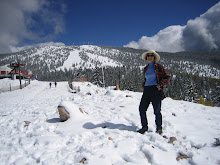EL CAMINO REAL-DAY TWO

Friday, March 2- Chihuahua
We have a hearty buffet breakfast in the Tierra Blanca Hotel comprising scrambled eggs, beans, rice and tortillas. Maestro Luis Urias, the second in command of our El Camino exploration, begins the day narrating our walking tour of the town where he grew up. As a young man, he studied in Mexico City,then returned 20 years later when his father died. We walk by stately buildings, many of which are included in Luis’s commentary. He knows their history.
At noon, we board the bus to see Chihuahua’s outlying areas. Luis points out “El Pasito,” an area known in the 1960s for selling electronics. Many of them were “lifted,” Luis says. We drive to the original city site, between a meeting of two rivers. Luis continues his discourse. The Basque influence in Chihuahua was very strong, he says.
We travel by an area of cement factories, a four-story adobe grain mill, and a huge convention center. Further on loom a technological institute and a ball park. Occupying several city blocks is Las Razas, a cement factory that uses fossil rocks from nearby white mountains for raw material.
The highlight of the afternoon is Quinta Carolina of Luis Terrazas, a scenic ruin that once served as estate for the Luis and his extended family. The estate’s buildings sprawl in every direction -- vast, crumbling, and desolate. The buildings include remains of a hacienda, stables, and a chapel. Luis explains that many of the walls have been diminished by people stealing material for new buildings. Plastic bags blow in the wind and odd pieces of barbed wire festoon pillars and partial walls. There is no reasonable explanation for the barbed wire except that perhaps it is part of an abandoned attempt to discourage intruders.
Luis Terrazas, who died in 1917, was extremely wealthy and powerful. Apparently his heirs cannot agree on what to do with their land. They retain the title. Allegedly, the family is having the buildings restored. There are no signs, however, of progress. The estate includes a church that is used for weddings and Sunday services.
Currently there are no signs of life at Quinta Carolina. The ruined buildings seem to be in a state of eternal limbo. An arrow points to “El Meson de la Quinta Carolina,” a restaurant operated by some of the family members. Either it is not open or not recommended, as we do not stop there for lunch. Instead we drive across dusty fields and the abandoned estate and drive to a pleasant restaurant called El Quintal. En route, Luis reclaims his position behind the microphone at the front of our bus.
Indians, he tells us, contributed the following to Mexican culture: astronomy, agriculture, architecture and artisans.
After a lunch of rice, guacamole with queso, empanaditas and flan, we return to the Tierra Blanca Hotel. We’re now free to walk about on our own. Inez and I walk to a bookstore, several blocks beyond where we thought it would be. We find great maps of Mexico and several paperbacks in English. I can’t resist buying Permed to Death, a Bad Hair Day Mystery.
Near the bookstore, we come to a towering obelisk topped by the statue of an angel. We stop for ice cream at a shop full of teenagers with designer jeans and cell phones, a Mexican version of the American Haagen-Daas. It is “Flor de Michoan,” apparently a chain. We ask for samples and settle on lemon and pine nut. Both flavors are delicious.







0 Comments:
Post a Comment
<< Home